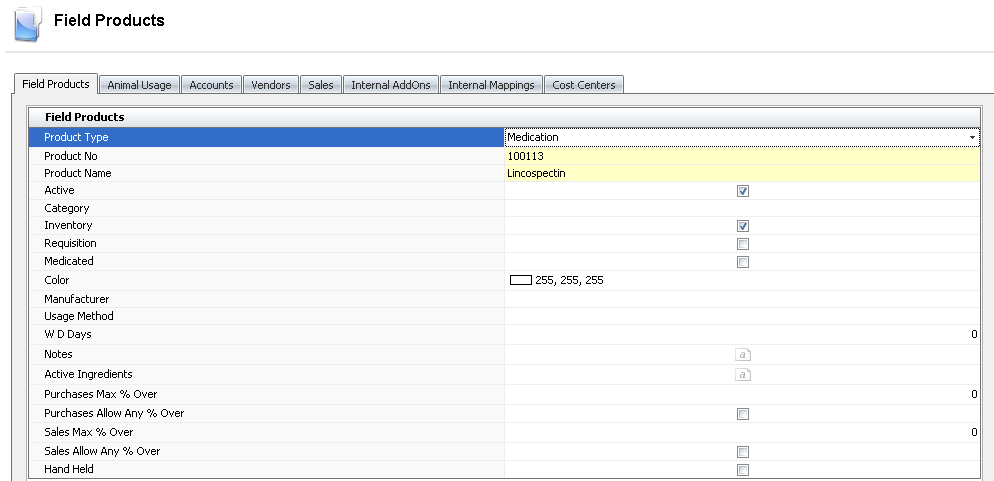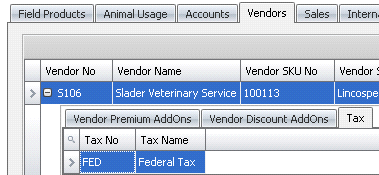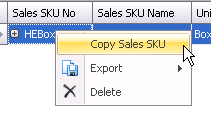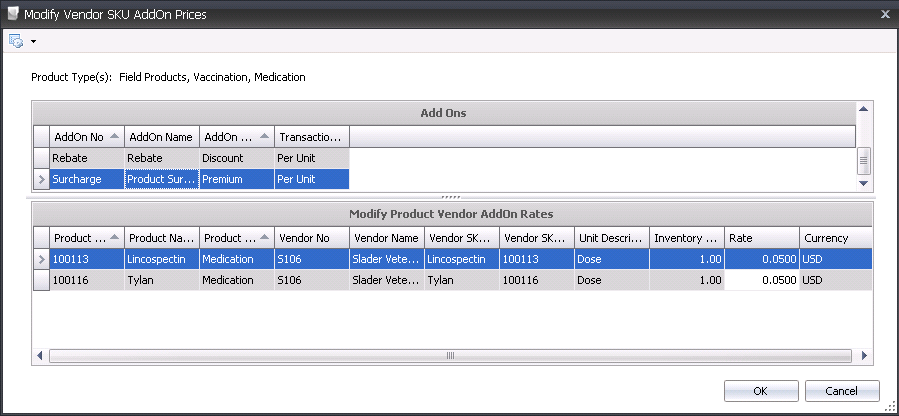Field products are products that are utilized at the farm such as medications, vaccinations and other miscellaneous supplies. Field products can be purchased and received to any facility or farm. There are two types of field products that are utilized. The process for setting up the products is the same with the exception of the inventory flag to determine if the product is maintain in inventory or not.
Inventory - products are received and inventory levels are maintained within MTech. If using the MTech purchasing process, products are received using purchase orders and receiving transactions to record the product in inventory. Usage and sales transactions will deplete the inventory. Otherwise, if the product inventories are being maintained outside of the system, an external transfer can be used to enter the quantities and costs into MTech inventory so that usage and sales transactions can be created.
Non-Inventory - non-inventory products are purchased and received but are recorded to an expense account and not inventoried. Non-inventory products can also be sold using order shipments.
Prior to creating a Field Product, the following items should be created.
The following features are outlined in this document:
The Ingredient Products screen has several tabs that must be completed in the creation process.
The General tab defines the basics about the product.
In General>General>Products, select Field.
In the Field
Products index, click  to create a new field product.
to create a new field product.
Click on the General
tab.

Enter the Product Type. This option will default in the proper account codes for the selected product type. Options are: Field Products, Medication, or Vaccinations.
Enter the Product No to identify the product within the system (alphanumeric, max 50 characters).
Enter the Product Name as a description for the product (alphanumeric, max 250 characters).
The Active flag will be selected by default. If the product is no longer utilized, de-select the Active flag.
Category is an optional field where the product can be assigned to a category. The categories must be pre-defined in Admin> Business> General> Definitions> Product Categories prior to being assigned to the product.
If the product is an Inventory product, check the box. Field products can be defined as either inventory or non-inventory products.
The Requisition flag determines if the product is available for the Material Resource Planning (MRP) process.
Field products can be defined as Medicated. If the medicated option is selected, there must be a prescription created for the farms or entities that are using the medicated product.
Products can be Color coded for easy view for planning purposes. If desired, choose the color from the color grid.
The Manufacturer field is optional and can be used to assign the manufacturer of the product. This is generally used for medications and vaccinations, and manufacturers must be pre-defined before selection.
Usage Method is used to define how the product is used (Example: Oral or Injected). This field is optional, and usage methods must be pre-defined in Admin>Business>General>Definitions>Usage Methods before selection.
WD Days is an optional field used to determine the number of days before processing that the product must be withdrawn.
In the Notes field, enter additional comments related to the product.
Active Ingredients is an optional field used to identify the active ingredients for the product.
Purchases Max % Over is used when the product has a tolerance percentage for the receiving transaction. (Example: The purchase order has 100 units. Max % Over is defined as 5%, which means the receiving transaction will allow up to an including 5 additional units).
Purchases Allow Any % Over can be selected if there is no limit and the purchaser can receive any quantity over the product units.
Sales Max % Over is used when the product has a tolerance sales amount for the receiving transaction. (Example: The sale order has 100 units and the Sales Max % Order is defined as 10%, which means the shipment transaction will allow for an additional 10 units to be shipped).
Sales Allow Any % Over is selected when there is no limit of shipping product units over what the customer has ordered.
Hand Held is selected if the product is used with FlockTrack which are handheld devices used to transfer data from the field to MTech.
The Animal Usage tab provides the option to define the modules and stages that utilize the field product. At least one option must be selected for this tab before the product can be saved.

Click on the Selected flag to indicate the stages where the field products are used. At least one stage must be selected for the product to be saved.
The default accounts established for the products are defined on the accounts tab. These will be displayed when the product is created. These accounts can be configured as required although it is recommended that only the Cost Element and User Element be modified. Non-inventory products may require additional accounts to be added depending on how the expense for the product is to be recorded.
Depending on the product type selected in the general screen, the Debit Element and Credit Element will be defined as follows:

Before a product can be purchased, the vendor/product relationship must be established. This option allows the user to define the unit of measure and any additional costs or discounts associated with the product. If the product is purchased from the same vendor in different units, a vendor sku must be created for each unit.

Vendor No contains a list of previously defined vendors. Select the vendor where the product is purchased from.
Vendor Name displays the name of the selected vendor.
In the Vendor SKU No field, enter the code that is used when ordering the products from the vendor (alphanumeric, max 50 characters). This is optional and can be the same as the product code; however the vendor SKU must be unique to the vendor.
In the Vendor SKU Name field, enter a description of the product that is being purchased. The field will be displayed on purchase orders (alphanumeric, max 100 characters).
In the Unit Description No field, select the required unit of measure in which the product will be purchased. The Unit Description No must be predefined in Admin>Business>General>Definitions>Units of Measure prior to being selected on the Vendors tab. Examples: tons, lbs, drum, box, dose, etc.
The Unit Description Name will default based on the selected Unit Description No.
Inventory Units indicates the number of units that will be added to inventory when the vendor unit is received. (Example: If a box of 20 units is purchased from the vendor, the user will receive 1 box and the inventory will be increased by 20 units). This value defaults based on the selected Unit Description No.

Pay Basis determines if the vendor is paid based on received units or shipped units. The default is set to Received, but it can be modified..
The system will default the vendor SKU as Active. If the product is no longer purchased from the vendor, de-select the option.
If the product is Taxable, the flag must be checked to calculate taxes on the product. The tax code can be optionally added to the Vendor SKU, but must be added to the purchase order for taxes to be calculated.
In the Attachment section, any type of file can be attached (Example: Word document, picture, music or video clip).
Payment Term No displays the payment terms and defaults from the vendor, with an option to select by product.
Currency No defaults from the vendor and displays the code for the currency, with an option to modify by product.
HS Code represents Harmonized System Code, which is used for international shipments. Enter the code based on the international defined code.
Product Specification is a text field to enter details related to the product vendor SKU.
Product Remarks is a text field to enter any other details specific to the vendor sku.
In the child grid within the Vendor No, there is the option to define the add-ons related to the product. The add-ons must be pre-defined in General>Products>AddOns prior to adding to the vendor sku. Depending on how the add-ons are configured, the cost of the add-on can be included or excluded from inventory cost of the product. The add-ons can be configured to be included in the cost of the product or alternatively, be coded to an entirely different account which is not included in the product cost.
There are two types of add-ons:
Premium add-ons add to the cost of the product.
Discount add-ons reduce the cost of the product.

In the Product No field, select from a list of previously defined add-ons codes. The add-ons will transfer to purchase orders created for the vendor SKU. AddOns can be found in: General>Products>AddOns
Product Name is a read-only field that displays the description of the add-on product type.
Transaction Basis is a read-only field that defaults from the selected add-on and determines how the add-on is calculated. Options are: Per Unit, Percentage, and Flat Rate. There is a Free Percentage option also available, however that option is only used in poultry products.
Payment Type determines when the add-on payment is made. Options available are:
Transaction: Processed at time of receiving and will be included in the vendor payment.
Rebate: Will record accrual amount at time of receiving but will not transfer to the invoice. Payment/invoice will be processed at a later date.
Internal: An internal transaction that is not invoiced to an external source (Example: There is an internal haulage department that gets a credit for hauling products).
The Payee Type field is optional. If the add-on is to be processed by an alternative sources, select the source type for the add-on. Options are: Customer, Vendor, Employee, or Cost Center. If the field is left blank, it assumes the vendor sku for the payment of the add-ons.
Transaction Entity ID is a required field if a different Payee Type is selected. Select the appropriate vendor or cost center.
Taxable identifies if the item is taxable or non-taxable when the item is purchased. Tax codes must be assigned to the purchase order for the taxes to be calculated.
If the product and/or add-ons are taxable, the tax codes can optionally be defined at the vendor sku. It is recommended that the tax codes are only entered on the vendor sku if that vendor only delivers within the same state or province, as different tax rate can be applied depending on the destination. Tax codes must be previously defined. Rates will default to the purchase order based on the rate that is in effect on the purchase order date.

Tax No is selected from the predefined in Admin>Business>General>Definitions>Tax Codes. The tax code will default to purchase contracts and purchase orders for the vendor sku.
Tax Name defaults from the selected Tax No.
If the product is sold to external sources, a sales sku must be created prior to creating a sales order.

In the Sales SKU No field,enter a unique code that will be used in creating sales contracts, orders, and price lists (alphanumeric, max 50 characters). This is optional and can be the same as the product code, however the sales sku must be unique within the Sales tab.
In the Sales SKU Name field, enter a description for the sales SKU. This will normally print on orders and invoices (alphanumeric, max 100 characters).
In the Unit Description No field, select the required unit of measure that the product will be shipped. The Unit Description No must be predefined in Admin>Business>General>Definitions>Units of Measure prior to being selected on the Sales tab.
The Unit Description Name will default based on the selected Unit Description No.
Inventory Units indicates the number of units that will be removed from inventory when the sales sku is shipped. (Example: If a box of 20 units is shipped, the user will enter 1 box, and the inventory will be decreased by 20 units). This value defaults based on the selected Unit Description No.
New sales skus' will default as Active. If the sales sku is no longer required, de-select the Active flag.
If the product is Taxable, the flag must be checked in order for taxes to calculate on the product. Tax codes must be entered on the price list, sales code, sales contract, or sales order for the taxes to be calculated.
There is also functionality included so that the sales SKU number can
be duplicated to create more sales SKU lines.


In the child grid within the sales sku, there is the option to define additional details such as added charges, discounts or commissions on the product.
The add-ons must be pre-defined before adding to the sales sku. The add-ons can be configured to be included in the revenue of the product or alternatively, be coded to an entirely different account which is not included in the product revenue.
Premium add-ons add to the price of the product.
Discount add-ons reduce the price of the product.

In the Product No field, select from a list of previously defined premium add-on codes. AddOns must be selected on the sales sku before being transferred to a contract, price list, or order. AddOns must be predefined in General>Products>AddOns.
Product Name displays the description of the selected add-on as defined.
The Transaction Basis is a read-only field that defaults from the selected add-on and determines how the add-on is calculated. Options are: Per Unit, Percentage, Flat Rate, or Free Percentage. Free Percentage is currently only used in poultry products.
Payment Type determines when the add-on payment is made. Options available are:
Transaction: Processed at time of receiving and will be included in the vendor payment.
Rebate: Will record accrual amount at time of receiving but will not transfer to the invoice. Payment/invoice will be processed at a later date.
Internal: An internal transaction that is not invoiced to an external source (Example: There is an internal haulage department that gets a credit for hauling products).
The Payee Type field is optional. If the add-on is to be processed by an alternative source, select the source type for the add-on. Options are: Customer, Vendor, Employee, or Cost Center. If the field is left blank, it assumes the customer for the add-ons.
Transaction Entity ID is a required field if a different Payee Type is selected. Select the appropriate customer or cost center.
Taxable Flag identifies if the item is taxable or non-taxable when the item is purchased. Tax codes must be assigned to the sales order for the taxes to be calculated.
Select Print on Invoice if the add-on is to be printed on the default system invoice. If the add-on is not to be printed on the invoice, the option should not be selected. This option can be further defined in price lists.
Commissions are a type of add-on that is typically used to pay employees or other parties based on a percentage or per unit amount.

In the Product No field, select from a list of previously defined premium add-on codes. AddOns must be selected on the sales sku before being transferred to a contract, price list, or order. AddOns must be predefined in General>Products>AddOns.
Product Name displays the description of the selected addon as defined.
The Transaction Basis is a read-only field that defaults from the selected addon and determines how the addon is calculated. Options are: Per Unit, Percentage, Flat Rate, or Free Percentage.
Payment Type determines when the add-on payment is made. Options available are:
Transaction: Processed at time of receiving and will be included in the vendor payment.
Rebate: Will record accrual amount at time of receiving but will not transfer to the invoice. Payment/invoice will be processed at a later date.
Internal: And internal transaction that is not invoiced to an external source (Example: There is an internal haulage department that gets a credit for hauling products).
The Payee Type field is optional. If the add-on is to be processed by an alternative sources, select the source type for the add-on. Options are: Customer, Vendor, Employee, or Cost Center. If the field is left blank, it assumes the customer for the add-ons.
Transaction Entity ID is a required field if a different Payee Type is selected. Select the appropriate customer or cost center.
Taxable Flag identifies if the item is taxable or non-taxable when the item is purchased. Tax codes must be assigned to the sales order for the taxes to be calculated.
The Bill of Materials tab is used to determine the products that must be used to ship the field product. Based on the products that are entered in this tab, the system will create automatic usage transactions for the products required to ship the field product

Product Type determines the type of product that will be used in the Bill of Materials. Any inventory product type can be selected.
Based on the selected product type, a list of available products will be available. Select the Product No that is required for the product to be shipped.
Product Name will default based on the selected product.
Inventory Units determines how many product units are required for each Bill of Material product. For example, in the first Cardboard Box example above, one small cardboard box will be required for every 25 units. Therefore, if 5 boxes are shipped, 125 product units will be used.
Instructions are default comments that are applicable to the product. These instructions are predefined in Admin>Business>General>Definitions>Instructions. Instructions are generally used to print on specific documents such as sales confirmations, invoices and hatchery work orders.

From Instruction No, select the instruction for the product that. Instructions are predefined in Admin>Business>General>Definitions>Instructions.
Instruction Name displays the description of the selected Instruction No. The Instruction Name will be the text that prints on the various forms or reports.
If the instruction is to print on the default system invoice, select the Print On Invoice option. If the instruction is not required to print on the default invoice, the option is not selected. These options can also be used in custom reports.
Internal add-ons are used when transferring products between facilities. The add-on must be defined on this tab before the pricing is established in Internal Pricing.

From Add-On Type, select whether the internal add-on is a premium or discount add-on. Premium will increase the cost to the destination cost center while the discount will reduce the cost to the destination cost center.
In the Product No field, click the box to select from a list of previously defined premium or discounts add-ons.
Product Name displays the description of the selected add-on as defined.
The Transaction Basis is a read-only field that defaults from the selected add-on and determines how the add-on is calculated. Options are: Per Unit, Percentage, Flat Rate, or Free Percentage.
Payment Type determines when the add-on cost is recorded. Options available are:
Transaction: Processed at time of transfer and will be included in the transfer journal.
Internal: Used when another department is required to be credited or debited for the add-on (Example: There is an internal haulage department that gets a credit for hauling products).
The Payee Type field is only required if the Payment Type is set to Internal. If this is the case, then the Payee Type should be set to Cost Center.
Transaction Entity ID is a required field if a Cost Center is selected as the Payee Type. Select the cost center that will receive the debit or credit for the add-on amount.
If the Rate is standard for all transactions, enter the rate in this field. If the rate is defined by cost center, then rates must be applied in Internal Pricing.
Accrual is selected if the amount of the add-on is reversed at period end with the internal price of the product. There is a separate period end task that will reverse any add-ons with the accrual option selected. If the option is not selected, the cost of the add-on will not be reversed at period end.
Internal mappings are not used when creating a field products.
The system has the ability to identify which cost centers the product applies to. If none of the options are checked, then the product can be supplied to all facilities. If one or more cost centers are selected, then the product can only be utilized at that facility.

In the Selected field, select the cost center (s) for which the product will be required.
There are three options available for field products:
The Reset Default Accounts sets the Product>Accounts tab back to the system defined default accounts. This process can be initiated from the index list or directly within the product.
The Modify Vendor SKU Add-on Prices option allows the user to modify the add-on prices from a single data entry screen rather than having to access each product to modify the prices. The feature can be initiated from the product type index to only change add-ons for that specific product type or from General>Products>Master to change the add-on prices for all product types in one screen.

The Auto Refresh option is selected by default. This option updates the index immediately when changes are made to the products. If the auto refresh option is not required, de-select the option and the index must be manually refreshed by the user.